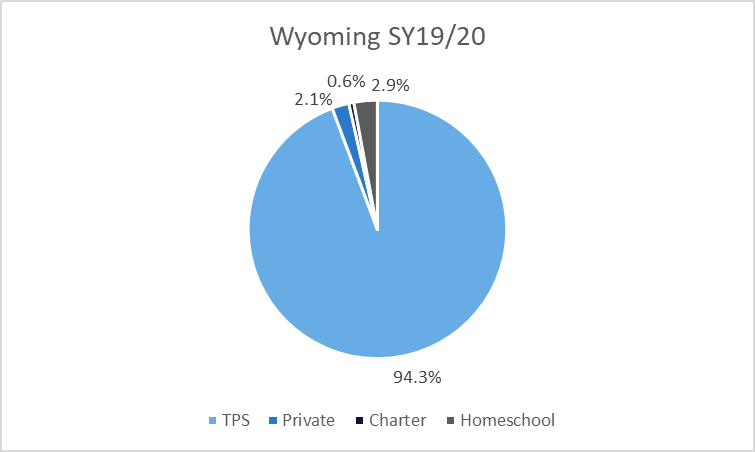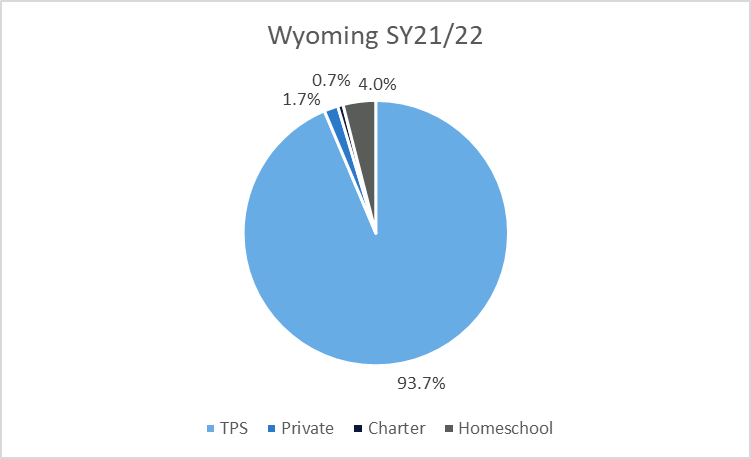While Wyoming's homeschooled students are not required to take an annual assessment, the state does offer the state test free of charge to homeschool families.
History
Wyoming, located in the western United States, legalized homeschooling in 1985. Homeschooling in Wyoming is defined as “a program of educational instruction provided to a child by the child’s parent or legal guardian or by a person designated by the parent or legal guardian.” According to the state, instruction to more than one “family unit” is no longer classified as homeschooling. W.S. §21-4-101(a)(v). However, enrolling in an umbrella “church” school is allowed. According to the state’s FAQ document, homeschooling is legally considered a nonaccredited private school.
Regulation
In Wyoming, students can school from home through either a home-based educational program or a “parochial, church, or religious school.” The state requires parents who elect to homeschool their children, ages 7 to 16, to either send a letter of intent or complete a registration form. Homeschool families must submit a curriculum to the local district annually, thus providing evidence that they meet the “basic academic education requirement.” W.S. 21-4-101(a)(v). Instruction in at least the core subjects of reading, writing, literature, math, science, and civics is required, with some variation depending on age.
There are no specific requirements for attendance, instruction time, or record keeping. Parents who direct their children’s education do not need to have a degree, diploma, or certificate to teach. The state does not have a testing requirement, but homeschooled students are “invited” to take the state assessment, free of charge.
Nonpublic students, including homeschooled students, may have some access to offerings at their local public schools. See W.S. 21-4-506(a). Fees and other restrictions or requirements may be involved.
According to the state policy, homeschooled students with special needs are not eligible for special services. Districts may, at their discretion, agree to provide some level of services. For more details, see here.
State Data
The Wyoming Deportment of Education has homeschool participation data available for download from 2018. The other estimates were collected and maintained by our researchers, which is why some years are missing. Until the pandemic, homeschool growth was slow. For example, 2,000 students reported homeschooling in 2000, but increased to over 4,000 at the height of the pandemic and slightly declined to 3,900 in 2022. The number of homeschoolers in Wyoming remained high post-pandemic.

Similarly, U.S. Census estimates indicate that around 6.5% of Wyoming families homeschooled in the spring of 2020 and increased to 12.9% by the fall of 2020. Both percentages are slightly higher than the national averages of 5.4% and 11.1%, respectively, during this time. Based on U.S. Census data, our calculations indicate that about 7.74% of K-12 students in Wyoming were homeschooled during the 2022-23 school year, and 7.30% during the 2023-24 school year. Due to survey changes, the data from 2020 reflects the percentage of households, while the data from following years reflects the percentage of students.
Cross-Sector Comparison
During the 2019-20 academic year, 2.9% of Wyoming’s K-12 students were homeschooled. The percentage of students attending private schools was slightly lower than that of homeschooled students, at 2.1%. Charter school participation in the state was even lower than private school participation, at only 0.6%. In 2021-22, 4.0% of Wyoming’s K-12 students were homeschooled, 1.7% attended private schools, and only 0.7% went to charter schools.


School Choice Context
In addition to homeschooling, parents in Wyoming have several educational choices available. These options include open enrollment in traditional public schools through inter- and intra-district choice, charter schools, and private schools. There are no private school choice programs in Wyoming.
Commentary
Wyoming could provide more access to educational opportunities for all nonpublic students in the state by expanding access to courses and extracurriculars already offered in the public schools. Publicly reporting the data the state collects from families could further understanding about homeschool participation trends. For example, information on student age and gender would better inform policy.

-
12.9% Families
Around 12.9% of families in Wyoming homeschooled during the height of the pandemic (Fall 2020).
-
1985 Legalized
Homeschooling was legalized in 1985 in the state of Wyoming.
-

-
More Information
12.9% Families
Around 12.9% of families in Wyoming homeschooled during the height of the pandemic (Fall 2020).
1985 Legalized
Homeschooling was legalized in 1985 in the state of Wyoming.

More Information
Last updated March 2025.